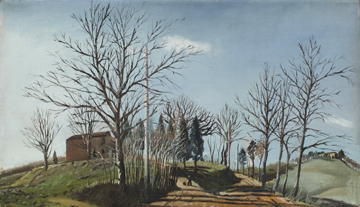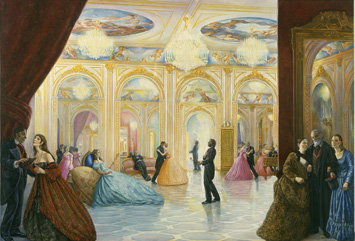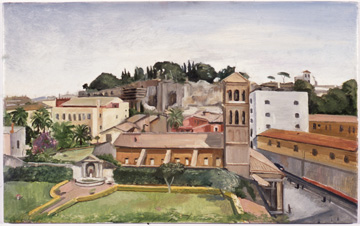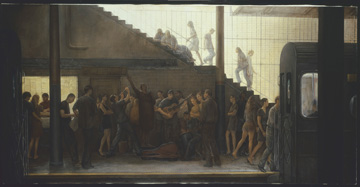Profile: Don Perlis
By Raymond J. Steiner
ART TIMES July/ August 2011
FOR THIS ARTWRITER, there can be no greater pleasure than spending an afternoon with a painter of Don Perlis’s stature. A true Emersonian “Delian Diver”, Perlis is a painter who feels, who sees, and above all, who thinks — a rare treat for this writer who, in his 35 years of writing about art, finds fewer and fewer such artists. A probing scholar, Perlis’s province not only includes his world of artistic knowledge and technical skill, but also of ancient lore, of mythology, of history — in brief, the world of man. His shelves in his study include books on such classical writers as Ovid and Homer, ancient writers about whom he constantly seeks newer — and better — translations. But this is no idle intellectual curiosity on his part; Perlis knows that there is never one translation of a given event, idea, or thing — and, given that his subject matter is largely representational, this is no small insight.
 “Quercerto In Winter” (18" x 32") “Quercerto In Winter” (18" x 32") |
To say that a given artist is “representational”, a “realist”, says little about that artist’s oeuvre. As we all soon discover, our ‘reality’ may not match up one-to-one with another’s — in fact, it cannot. Each of us comes into the world with our own unique point of view. We sometimes forget that no one — no one — has ever seen the world from precisely our point of view, since no one has the same gamut of experiences and observes from the same vantage point, as do we. Again, they cannot — and this holds true for persons of the same family as it does for persons ofdifferent temperaments, different cultures, and different times.Broadly speaking, this is what we refer to as the “human condition.”
Furthermore, since time immemorial, it has been recognized that artists have been ‘gifted’ with a ‘sight’ that is more complex — or at least ‘different’ — from the rest of us, something that was called during the renaissance, “divine inspiration” (literally, ‘breathed into’ by a higher power). One of the secrets held by the great masters, however, was that it takes an open mind to be ‘breathed into’. Seeing ‘reality’ as might an artist, however, is not the same as seeing it through the eyes of a particular artist — hence the true meaning of an artist’s “aesthetic vision”, i.e. the individually unique view of the phenomenal world that is the human inheritance of each of us. You and I might live with it; the artist is tasked with representing it in whatever medium with which he is gifted.
 “Levitation” (68" x 50") “Levitation” (68" x 50") |
All of which Perlis is acutely aware — and all of which appears in his art. Other subjects — subjects that have fed the imagination of classical artists over the centuries — are, of course, not the only branches of human thought that capture his interest — there is above all, the vast realm of art. Although Antonio Allegri, called Corregio, often came up while in conversation with Perlis, his breadth of concentration and study covers a wide range of classical painters, the Emilian Corregio just one of many — albeit an important one in that the Italian painter was a master of luxurious light and texture, important elements in Perlis’s own art. If you claim the title of painter and want to bring honor to your profession, these are certainly some masters you might want to emulate.
In light of Perlis’s wide intellectual arena, perhaps it is more than simple serendipity that the Emilian artists were centered in Bologna, the site of one of the world’s oldest universities. There were, of course, the other 16th Century Emilians — Parmigiano, Orsi, Dossi, Pellegrino Tibaldi, and the Carracci — but Perlis did not stop his studies with them. A world traveler, he has visited almost every major European museum, imbibing the finer points and insights of representational painters from various eras and cultures, noting each unique vision of what — to most — appears as a flat, nondescript (if not familiar) tableau. A delver himself, Perlis constantly endeavors to plumb the depths of his forerunners, always attempting to go that one step deeper that will lead him into his own inner resources.
 “La Traviata” 88"x132" “La Traviata” 88"x132" |
Nor do Perlis’s ‘resources’ come easily. He has pursued and refined them since his earliest days as an artist — and, although drawn to the realist image from the beginning, had early intuited that his reality had to be fought for. Thus, a series of schools — including New York’s High School of Art and Design, The Art Students League, The School of Visual Arts and Skowhegan School in Maine, and the American Academy in Rome — were chosen to enhance that early predilection. Limiting his circle of artist friends to like-minded painters — even helping to co-found the Artist’s Choice Museum in New York City (along with several who were active in the Alliance of Figurative Artists) in 1976 — Perlis’s career as an artist is paralleled by his career as a scholar in his chosen métier.
One need only trace the history of a single painting — for the purposes of this review, I will choose only one, a 40x60 narrative work-in-progress based on Puccini’s Madama Butterfly. With a focal point that depicts the moment when Lieutenant Pinkerton of the United States Navy presents himself under a moonlit sky to Cio-Cio San (Madama Butterfly), the painting includes a large entourage of well-wishers and onlookers. If the description of the painting takes but a few moments, the execution of it under Perlis’s brush is anything but hurried — already two years in the making, the painting is still not “finished” in his eyes. Puccini may have written five versions of events that, according to one scholar, actually took place in Nagasaki in the 1890’s, but his handful of revisions pale in the face of Perlis’s innumerable studies, sketches (toppling piles of sketchbooks cascade over an already cluttered worktable in his studio), scrapings, revisions and glazes that take place before he achieves the proper tonal values, color scheme, and pictorial composition he desires. Perlis also researched Japanese hair styles, clothing, patterns, parasols, architecture — even flora — searching a verisimilitude for his tableau that few attempt to pursue — no less achieve — a verisimilitude that would not only meet the discerning eye of the most fastidious perfectionist, but, more importantly, one that would satisfy his own vision. Each hairstyle, each fold, each nuance of light or texture has to suit him, Don Perlis, regardless of the onlooker’s taste and/or judgment. And, Perlis’s “Madame Butterfly”is but one of his large-scale paintings. There are not only other paintings based on operas, but on the illusion of magic, the everyday scenes and sometime dangers of New York City subways — even “allegories” of love based on the writings of the French philosopher Georges Bataille.
 “View From Velabro” (8” x 16”) “View From Velabro” (8” x 16”) |
It is not only difficult, but perhaps also irrelevant to point to one motif as a “signature” Perlis work — for not only does he work in a wide range of canvas size (his smaller canvases often ‘sketches’ gleaned from his travels), but also in a varied repertoire of subjects: the nude (one of his staples), the landscape, the interior, the still life, the city-scape — indeed, in just about any subject that captures his fancy. Thus, if Perlis has a “signature” it is to be found in his painterly work ethic and not in his choice of motifs — in brief, his purpose of bringing honor to his craft. Little wonder that he had his first public showing at a museum — the Whitney in 1970 — and that, after garnering an impressive list of awards and honors — including being elected to the National Academy of Design in 1994 — his work is highly prized and sought after by both collectors and major New York City galleries.*
 “The Jazz Singer, Astor Place” (60” x 120”) “The Jazz Singer, Astor Place” (60” x 120”) |
Intense, literate, direct, it is difficult to imagine Don Perlis succumbing to the mostly vacuous, occasionally silly, “modern” taste for meaningless art. Not in the least interested in the passing fad (no matter how lucrative such inanities might be in the current zeitgeist), Perlis intends for his art to stand the test of time, to be “seen” for what it is by those who know how to truly look — no matter how many years that may take. That he takes such pains to make sure that his art speaks to — and for — him, there seems more than a good chance that he will succeed in reaching others.
For this observer, I am convinced Don Perlis and his humanist aesthetic vision will prevail.
*For a full résumé and more on Don Perlis’s work, visit him at www.donperlis.com.
